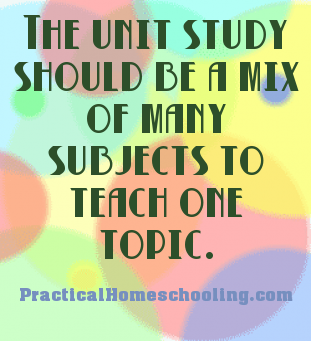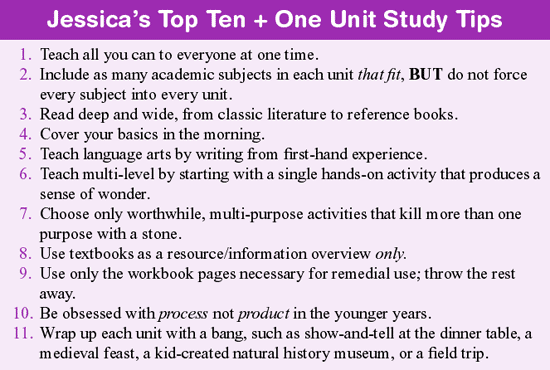 Public education and homeschool have different goals for unit studies. While one may seek to camouflage the actual course of study, the other seeks to preserve children's sense of wonder.
Public education and homeschool have different goals for unit studies. While one may seek to camouflage the actual course of study, the other seeks to preserve children's sense of wonder.
In public schools, unit studies are usually called "study units." More than the name is different, though. Although both "study units" (or just "units," as they are often called) and "unit studies" bring many subjects together under one main unit topic, the goals of most public school "units" is either to fill up the time with trivialities such as constructing a shoe box village to make holders for valentine cards (here the "subjects" employed are art and holidays) or to indoctrinate children in a politically correct worldview.
Such public school units often blur the lines of separation between the different academic subjects, so parents have difficulty determining what subjects are actually being studied and what material is actually being covered. Conscientious parents may become frustrated when their ability to oversee their child's education is nullified, because the all-in-one teaching of units obscures the fact that Johnny is really not learning science or history, but instead is studying politically correct ways to preserve the rain forest.
At home it is a different story. Here, integrating subjects allows subjects to be taught naturally in an unfragmented approach. Units preserve the unity, the interrelatedness and the wonder of God's creation. Unit studies work well for homeschooling, because the art teacher is the history teacher and the English teacher all rolled into one - Mom! The only faculty meeting necessary to correlate the subjects is in Mom's mind. An art project, say a papoose carrier, can fit right into a history demonstration and an English report on the Apache Indians. When students dramatize the Constitutional Convention, they are covering the subjects of history, drama, speech, debate, and even art through the making of their costumes. A unit on the classification of plants must be accomplished by reading The Secret Garden (at least, I think so!). Yes, the lines are blurred between the subjects, yet when subjects are meshed together, each is enhanced by the others.
Cynthia Pilling, the KONOS representative in Florida, recently trained a group of parents in How To Teach with Unit Studies. Instead of telling them how to integrate subjects and make learning hands-on and fun, she decided to teach them by giving an actual lesson. Her unit topic was "birds." Naturally, she would have included sketching birds as well as reading about John James Audubon, but her real goal was to have the parents participate in a hands-on activity. Laying out an assortment of tools that represented the birds' beaks as well as an assortment of birds' food, the parents were instructed to choose the best beak for the various foods. Nuts were cracked by pliers, a coffee filter was used to catch flying insects (mini marshmallows), while tongs were used to dig through peanut butter (mud) to pluck out a prized gummy worm.
For exercise, Cynthia had the parents stand up and flap their wings to see if their muscles tired easily. Then she told them how fast the hummingbird flapped its wings. They were amazed! As they talked about nests of birds, Cynthia passed out a milk carton cap to each parent. Placing one navy bean in each cap, she told them that the cap was the size of a hummingbird nest and the bean was the size of a hummingbird egg.
Although there had been much talking and bantering by the "students" during the other activities, as soon as the size of the hummingbird egg was revealed, all became quiet. The sense of wonder had overtaken them.
One mom put it so well when she said, "I knew it was small, but I never realized it was like this." Cynthia commented to the group of awestruck parents, "Isn't this what you want to give to your children?" A sense of wonder had been preserved.
